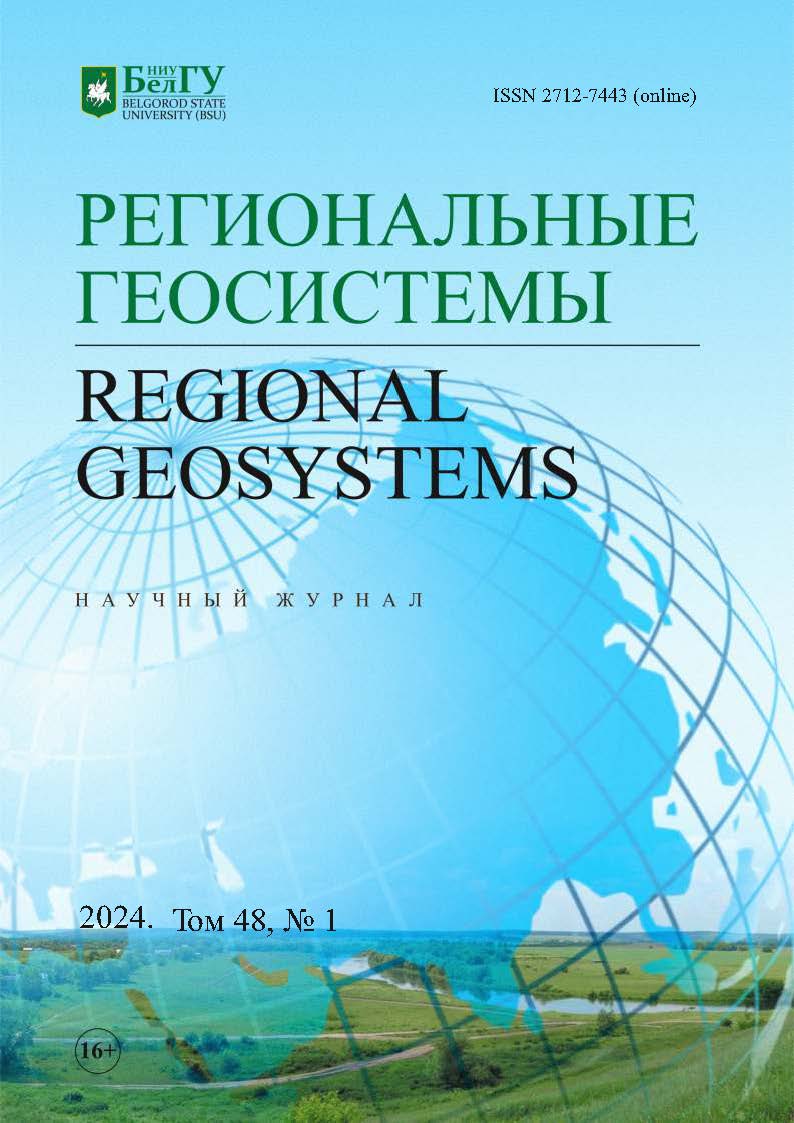The Concept of Land Cover as a Basis for Remote Sensing Monitoring of Land
DOI:
https://doi.org/10.52575/2712-7443-2024-48-1-77-90Keywords:
Land Cover, land monitoring, land cover classification, remote sensing, Landsat, Sentinel-2Abstract
Based on the analysis of literature primary sources, a review of the most frequently used definitions and approaches to the classification of land cover objects (Land Cover) is made. It was found that authors often mix the concepts of land cover with the concepts of "vegetation" and "land". The most logical understanding of land cover as a (bio)physical state of the earth's surface. The mixing of land cover objects with vegetation and land use leads to the fact that land cover classifications used in the world also often include objects from the classifications of vegetation, soils, landscapes, and land use. The most logical and detailed is the classification of the world land cover developed under the auspices of FAO in 2000. On the basis of this classification the classification of land cover is proposed taking into account the specifics of the territory of Russia. It is found that combinations of land cover classes are regularly repeated in space. New approaches to the classification of spatial combinations of land cover based on the analysis of contrast and spatial subordination of land cover classes are proposed.
Acknowledgements: The work was carried out within the framework of realization of the most important innovative project of state importance "Development of the system of ground and remote monitoring of carbon pools and greenhouse gas fluxes on the territory of the Russian Federation, provision of creation of the system of accounting data on the fluxes of climatically active substances and carbon budget in forests and other ground ecological systems" (reg. № 123030300031-6).
Downloads
References
Вельтищев Н.Ф., Семенченко Б.А. 2005. Дистанционные методы измерений в гидрометеорологии. М., МГУ, 129 с.
CEC (Commission of the European Communities). 1993. CORINE Land Cover – Guide technique. Brussels.
Global land products. Electronic resource. URL: https://www.aboutgis.com/Publications/ Mountrakis_IJRS_2015_Global_land_products.pdf (date of the application 18.01.2024).
Land cover map. Electronic resource. URL: https://wiki.openstreetmap.org/wiki/Landcover (date of the application 18.01.2024).
NASA. Electronic resource. URL: https://neo.gsfc.nasa.gov/view.php?datasetId=MCD12C1_T1 (date of the application 12.01.2024).
Ocean service. Electronic resource. URL: https://oceanservice.noaa.gov/facts/lclu.html (date of the application 12.01.2024).
UNEP. Electronic resource. URL: https://www1.biologie.unihamburg.de/bonline/afrika/ africa_forest/www.unep_wcmc.org/forest/global_map.htm (date of the application 12.01.2024).
UNEP/FAO. 1994. Report of the UNEP/FAO Expert Meeting on Harmonizing Land Cover and Land Use Classifications. GEMS Report Series, 25 p.
What does land cover. Electronic resource. URL: https://ids-water.com/2020/05/06/what-does-land-cover-include/ (date of the application 12.01.2024).
What is a land cover. Electronic resource. URL: https://mv-organizing.com/what-is-a-land-cover-type/ (date of the application 17.01.2024).
Лупян Е.А., Савин И.Ю., Барталев С.А., Толпин В.А., Балашов И.В., Плотников Д.Е. 2011. Спутниковый сервис мониторинга состояния растительности («ВЕГА»). Современные проблемы дистанционного зондирования Земли из космоса, 8(1): 190–198.
Макарова М.А., Владимирова Н.А. 2020. Обзор ресурсов открытых пространственных данных о растительном покрове земли в сети интернет. Ботанический журнал, 105(4): 387–407. https://doi.org/10.31857/S0006813620040067.
Савин И.Ю., Жоголев А.В., Прудникова Е.Ю. 2019. Современные тренды и проблемы почвенной картографии. Почвоведение, 5: 517–528. https://doi.org/10.1134/S0032180X19050101.
Фридланд В.М. 1972. Структура почвенного покрова. М., Мысль, 336 с.
Anderson J.R., Hardy E.E., Roach J.T., Witmer R.E. 1976. A land use and land cover classification system for use with remote sensor data. Washington, United States Government Printing Office, 28 p.
Asadzadeh S., de Souza Filho C. R. 2016. A Review on Spectral Processing Methods for Geological Remote Sensing. International Journal of Applied Earth Observation and Geoinformation,
: 69–90. https://doi.org/10.1016/j.jag.2015.12.004.
Bartholomé E., Belward A., Frédéric A., Bartalev S., Carmona-Moreno C., Eva H., Fritz S., Grégoire J.M., Mayaux P., Stibig H.J.E.E. 2002. GLC 2000: Global Land Cover Mapping for the Year 2000: Project Status November 2002. Italy, Institute for Environment and Sustainability, 66 p.
Dharumarajan S., Seenipandi K., Adhikari K., Manickam L., Kumar N. 2023. Remote Sensing of Soils. Mapping, Monitoring, and Measurement. Elsevier, 717. https://doi.org/10.1016/C2022-0-00254-3.
Di Gregorio A., Jansen L.J.M. 2006. Land Cover Classification System (LCCS): Classification Concepts and User Manual. Rome, CD-ROM. FAO, 179 p.
Fuller R., Smith G., Sanderson J., Hill R., Thomson A., Clarke R. 2000. Countryside Survey 2000 Module 7: Land Cover Map 2000. NERC/Institute of Terrestrial Ecology, 99 p.
Hansen M.C., Potapov P.V., Pickens A.H., Tyukavina A., Hernandez-Serna A., Zalles V., Turubanova S., Kommareddy I., Stehman S.V., X-P Song. 2022. Global Land Use Extent and Dispersion within Natural Land Cover Using Landsat Data. Environmental Research Letters, 17(3): 034050. https://doi.org/10.1088/1748-9326/ac46ec.
Jansen L., Di Gregorio A. 2000. Land Cover Classification System (LCCS): Classification Concepts and User Manual. Rome : Food and Agriculture Organization of the United Nations, 190 p.
Kaur R., Pandey P. 2022. A Review on Spectral Indices for Built-Up Area Extraction Using Remote Sensing Technology. Arabian Journal of Geosciences, 15: 391. https://doi.org/10.1007/s12517-022-09688-x.
Loveland T.R., Reed B.C., Brown J.F., Ohlen D.O., Zhu Z., Yang L., Merchant J. W. 2000. Development of a Global Land Cover Characteristics Database and IGBP DISCover from 1 km AVHRR Data. International Journal of Remote Sensing, 21(6–7): 1303–1330. https://doi.org/10.1080/014311600210191.
Schmugge T.J., Kustas W.P., Ritchie J.C., Jackson T.J. 2002. Al Rango Remote Sensing in Hydrology. Advances in Water Resources, 25(8–12): 1367–1385. https://doi.org/10.1016/S0309-1708(02)00065-9.
Stephens G.L., O'Brien D., Webster P.J., Pilewski P., Kato S., Li J. 2015. The Albedo of Earth. Reviews of Geophysics, 53(1): 141–163. https://doi.org/10.1002/2014RG000449.
van Minnen J.G., Fischer G., Stolbovoi V. 1996. A Land-Cover Classification for Modeling Natural Land Cover within the IIASA LUC Project. Laxenburg, Austria: WP-96-026.
Vincent R.K. 1997. Fundamentals of Geological and Environmental Remote Sensing. Prentice Hall, Upper Saddle River, 370 p.
Yang J., Xin H. 2021. The 30 m Annual Land Cover Dataset and Its Dynamics in China from 1990 to 2019. Earth System Science Data, 13 (8): 3907–3925. https://doi.org/10.5194/essd-13-3907-2021.
Xie Y., Sha Z., Yu M. 2008. Remote Sensing Imagery in Vegetation Mapping: a Review. Journal of Plant Ecology, 1(1): 9–23. https://doi.org/10.1093/jpe/rtm005.
Abstract views: 196
Share
Published
How to Cite
Issue
Section
Copyright (c) 2024 Regional Geosystems

This work is licensed under a Creative Commons Attribution 4.0 International License.


